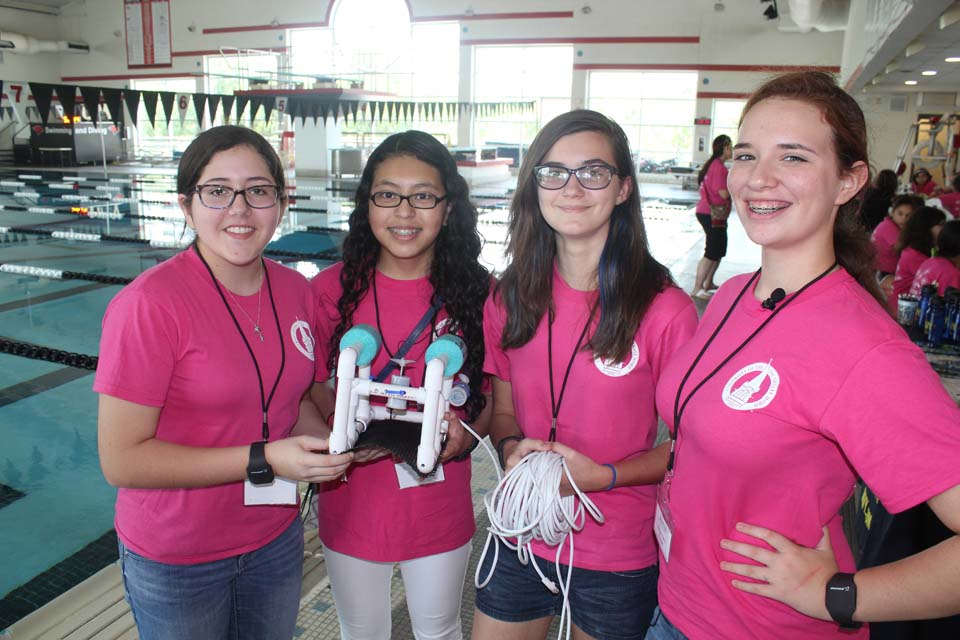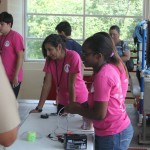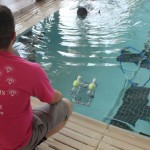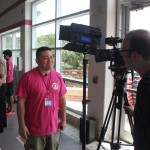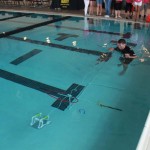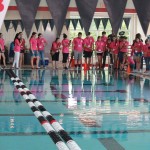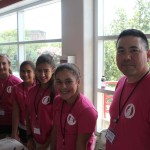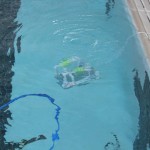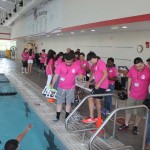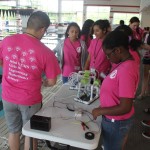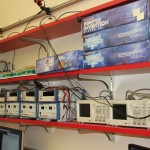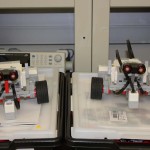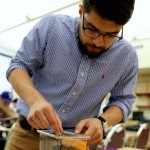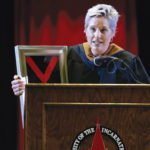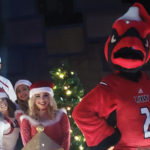Innovation is often born of the simplest of moments. For Dr. Michael Frye, associate professor of engineering, and Dr. Sreerenjini Nair, assistant professor of physics, one such moment came last spring, which led to the hosting of the first engineering camp by the University of the Incarnate Word’s (UIW) Autonomous Vehicle Systems (AVS) Research and Education Lab.
“Dr. Nair and I attended a Rawlinson Middle School Parent’s Night last March where we were giving several presentations about the AVS lab,” explained Frye. “In between breaks, we came up with the idea of miniGEMS (Girls in Engineering, Mathematics, and Science) with the Rawlinson Middle School science teachers.”
“The engineering camp was an idea that Dr. Frye mentioned and my colleague Angela Meyer and I were thrilled to recruit students and work the camp,” said Cheri Barrera, science teacher at Rawlinson, which is part of Northside Independent School District. “We are connected to UIW through our robotics club. UIW engineering students mentor our students as they prepare for an EV3 robotics competition in the spring.”
From July 6-10, miniGEMS 2015 was held on UIW’s campus. The event, aptly named by Nair, is a five-day engineering camp for middle school girls to introduce them to the field of engineering through robotic projects, competitions, guest speakers and field trips.
The camp, planned and directed by Frye and Nair, included 26 middle school students from the Northside Independent School District (NISD), Northeast Independent School District (NEISD) and San Antonio Independent School District (SAISD). They worked closely with the districts to identify and choose the students who would attend miniGEMS.
Frye explained, “The students primarily came from the middle school science courses and robotic clubs. The application was first-come, first-serve. We initially were only going to accept 24 but due to the level of interest we were able to increase the number.”
Additionally, four engineering research assistants from AVS helped with the daily robotics projects and competition, and three middle school science teachers from NISD and SAISD assisted all week with the camp.
Funding was made possible by a grant from the Texas Higher Education Coordinating Board (THECB) Engineering Summer Program. The dean’s office of the School of Mathematics, Science and Engineering (MSE) provided snacks and lunches and paid for a banquet at the McCombs Center Rosenberg Sky Room.
“We were funded primarily by the THECB program which we were awarded in early June,” Frye said. “Between June and July we worked around the clock to plan the curriculum and manage the administration of the camp.”
The first half of the week, students focused on the EV3 Mindstorms, customizable, programmable robots manufactured by LEGO. The students learned about robotics, autonomous land navigation and computer programming.
Erik Coronado ’15 BA BS, AVS engineering research assistant, helped with preparation and performance of various camp activities and logistical challenges. In addition, Coronado gave a presentation to the students that focused on one of his current projects in the AVS lab involving Madagascar hissing cockroaches. The students had the opportunity to touch and interact with the live cockroaches as they learned about their behavior and how it could be applied to the understanding of robotics, a primary focus of the camp’s engineering section.
Coronado said other projects included building raw spaghetti towers, marshmallow-wheeled cars, and assembling LEGO EV3 hardware to work alongside the corresponding software.
- miniGEMS campers navigate the SeaPerch robots.
- Coronado, AVS research assistant, observes a SeaPerch robot during the miniGEMS competition.
- A SeaPerch robot navigates through an obstacle course.
- A SeaPerch robot navigates through an obstacle course.
- miniGEMS competition at the Natatorium.
- Frye is interviewed by local media at the miniGEMS competition.
- San Antonio Naval Recruiting District personnel is interviewed by local media at the miniGEMS competition.
- A SeaPerch navigates through an obstacle course.
- A SeaPerch robot navigates through an obstacle course.
- miniGEMS competition at the Natatorium.
- miniGEMS competition at the Natatorium.
- Frye poses with miniGEMS campers.
- Coronado and miniGEMS campers observe a SeaPerch moving through an obstacle course.
- A SeaPerch navigates through an obstacle course.
- A SeaPerch navigates through an obstacle course.
- miniGEMS competition at the Natatorium.
- Coronado speaks with campers at the SeaPerch competition.
- Campers construct SeaPerch robots for the competition.
- LEGO Mindstorms stored in the AVS lab.
- LEGO Mindstorm robots.
- Frye poses with students in the AVS lab.
- Frye in UIW’s AVS lab.
- Coronado studies a Madagascar hissing cockroach.
- Coronado studies a Madagascar hissing cockroach.
- A Madagascar hissing cockroach in the AVS lab.
- Coronado studies a Madagascar hissing cockroach.
During the week, students had an opportunity to tour the campus led by Sr. Walter Maher, CCVI, UIW vice president for Mission and Ministry.
On July 9, the miniGEMS students were able to design and compete using SeaPerch underwater robots at UIW’s Ann Barshop Natatorium. They gained hands-on experience in building robots as a team. The robots were guided by remote control through an underwater obstacle course. A grant from the Office of Naval Research provided the SeaPerch robots and San Antonio Naval Recruiting District personnel were in attendance to support the competition. Frye noted the event marked the first time SeaPerch robots were used for a middle school girls’ competition in Texas.
“It was very rewarding to watch them compete with their robots and work together as a team despite their different backgrounds,” said Barrera.
On the last day, a field trip on digital art and engineering was conducted and an awards presentation and banquet was held at the Sky Room for outstanding research achievements.
Not only is miniGEMS unique and innovative in terms of UIW’s collaboration with the school districts and the Navy, but also in exposing middle school-aged girls to the field of engineering.
“The collaboration between NISD and UIW is powerful because it allows us to reach a wider spectrum of female students,” said Barrera. “And miniGEMS is special because it gives our female students the skills needed to be confident in the engineering field.”
“As of 2008, only about 20 percent of engineers were women,” said Coronado. “Out of the 20 percent of female engineers that make up the entire engineering population, only about 12 percent have received a bachelor’s degree in engineering and only a little over 1 percent for Ph.D. So, effectively, 2.4 percent of all engineers are minority women—this is one of the main issues miniGEMS wants to address.”
Additionally, AVS worked with the middle school teachers and students’ parents to talk about engineering and what courses to take in high school to prepare them for engineering at college.
“There is already a national shortage of engineers in the United States, especially of women engineers,” stressed Frye. “By targeting middle school girls to the field of engineering at an early age, we are hoping that as they progress through their course work in high school, they will consider going into an engineering major when they enter college.”
Frye noted that student-camp surveys indicate that campers are motivated by daily activities and mini-projects, and he believes miniGEMS helps to enhance the campers’ interest in engineering and science, a sentiment Barrera shares.
“The girls were building and programming robots that many adults would not even be able to attempt,” said Barrera. “By the end of the camp, nearly every girl asked to come back the following year.”
The AVS lab is planning to add at least two more camps, which may be based on funding levels for next summer. Therefore, AVS is currently seeking additional funding sources for miniGEMS.
Overall, for those involved, the indelible impression the camp leaves on students is most significant.
“The miniGEMS camp allows the AVS lab to participate in the Mission of UIW by working with the local San Antonio community,” said Frye. “We feel that by introducing middle school students to the field of engineering, we are having an impact on their lives.”
“It was a fantastic opportunity not only for the girls, but for us teachers as well,” shared Barrera. “We learned a lot about integrating engineering into our classrooms and the excitement of the girls was incredibly inspiring.”
“We seek to have a positive impact,” concurred Coronado, “in the face of the gravity of the statistics, in the lives of these young ladies by helping to show them the true potential that each and every one of them possesses.”
By Brance Arnold ’10 MA

